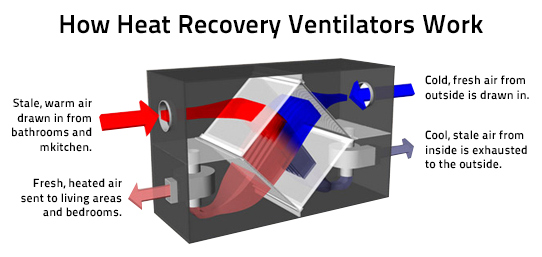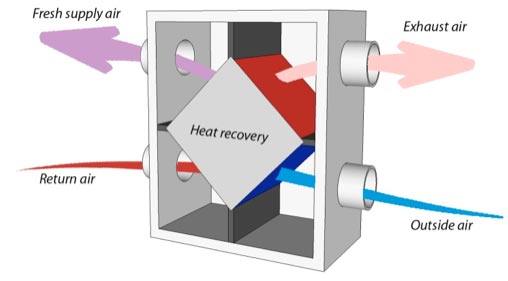Misconceptions About HRV That Homeowners Should Know
Wiki Article
How Heat Recovery Ventilation Boosts Indoor Air Quality and Reduces Power Costs
Heat Recovery Ventilation (HRV) systems play a crucial function in boosting indoor air top quality while simultaneously reducing power expenditures. By efficiently trading stagnant interior air with fresh outdoor air, HRVs assist maintain optimal humidity and lower pollutants. Furthermore, their capacity to recover warm from outward bound air minimizes the stress on home heating and cooling down systems. As energy costs continue to climb, recognizing the full capacity of HRV systems comes to be increasingly crucial for homeowners and companies alike.Comprehending Heat Recovery Ventilation Equipments

Heat recovery ventilation (HRV) systems play a crucial role in enhancing indoor air high quality, specifically in modern-day, energy-efficient buildings. These systems are created to move warmth from the outgoing stale air to the incoming fresh air, thereby lessening power loss while maintaining perfect temperature degrees inside your home. HRVs are composed of a warmth exchanger, followers, and ductwork, helping with the constant flow of air. By expelling interior toxins and presenting fresh air, HRVs aid to balance moisture degrees, protect against mold and mildew development, and lower irritants. The performance of HRV systems depends on their ability to recoup approximately 80% of the warm from the worn down air, promoting power conservation while ensuring a healthy and balanced indoor setting. Their integration is essential in achieving sustainable living methods.
The Value of Indoor Air Quality
Indoor air quality (IAQ) is a vital factor affecting the wellness and wellness of residents in any environment. Poor IAQ can bring about different wellness concerns, consisting of respiratory troubles, allergic reactions, and tiredness. Furthermore, it can exacerbate status quo such as bronchial asthma. Elements adding to reduced IAQ include contaminants from interior sources like cleaning up representatives, mold, and inadequate ventilation. Consequently, preserving great IAQ is essential for advertising a risk-free and comfortable living or functioning room. Reliable approaches to enhance IAQ entail normal surveillance of air quality, correct air flow systems, and reducing the usage of unsafe compounds indoors. By focusing on IAQ, people can ensure a much healthier environment that promotes efficiency and overall quality of life.Power Performance Perks of HRV Solutions
Numerous homeowners and structure supervisors are progressively recognizing the power effectiveness benefits of warmth recovery ventilation (HRV) systems. By moving warm from worn down interior air to incoming fresh air, HRV systems significantly reduce the power needed for cooling and heating. This procedure decreases reliance on traditional cooling and heating systems, causing lower power costs. Additionally, HRVs aid preserve a well balanced interior environment, avoiding extreme home heating or cooling demands. The ability to recoup up to 90% of the warmth from outbound air also sustains sustainability efforts by minimizing total energy intake. HRV systems add not just to cost savings however also to a reduced carbon impact, aligning with the expanding focus on energy-efficient building techniques.Installation and Maintenance Considerations
The efficient implementation of warm recuperation ventilation (HRV) systems calls for cautious consideration of setup and maintenance elements to guarantee peak performance. Appropriate positioning of the HRV system is crucial, as it ought to be set up in a place that takes full advantage of air movement while decreasing noise disturbance. In addition, ductwork has to be appropriately sized and shielded to stop power loss. Regular maintenance, including filter substitute and system cleansing, is essential to secure ideal functionality and indoor air top quality. Owners need to develop a regular maintenance timetable to recognize and attend to prospective concerns prior to they escalate. Cooperation with seasoned professionals throughout both installation and maintenance stages can improve the longevity and efficiency of HRV systems, inevitably resulting in better interior atmospheres and minimized power costs.
Real-World Applications and Success Stories
Checking out real-world applications of warmth healing ventilation (HRV) systems discloses their substantial influence on indoor air top quality and power performance across different settings. In domestic structures, home owners have actually reported improved air high quality, resulting in fewer allergic reactions and respiratory system concerns. Schools carrying out HRV systems have kept in mind improved trainee concentration and lowered absenteeism as a result of better air flow. Commercial buildings, such as workplaces and retail spaces, have actually experienced reduced energy prices and increased worker productivity. As an example, a corporate office in a pleasant climate accomplished a 30% decrease in power expenses after mounting an HRV system. These success tales show that HRV innovation not just adds to healthier atmospheres however additionally offers concrete financial advantages, making it a valuable financial investment for various fields.Regularly Asked Inquiries
Can HRV Equipments Lower Irritants in Indoor Air?
The effectiveness of HRV systems in minimizing indoor allergens primarily depends upon their ability to filter and exchange air. HRV Heat Recovery Ventilation. By continuously changing stagnant air, these systems can greatly reduce irritant levels throughout indoor atmospheres
Exactly How Does Humidity Affect HRV System Performance?
Humidity substantially influences HRV system performance; high levels can lead to condensation, minimizing performance, while low humidity might improve air exchange. Balancing moisture is essential for ideal operation and maintaining indoor air high quality.Are HRV Systems Noisy During Operation?
HRV systems can produce differing sound degrees throughout procedure, depending upon their layout and setup. Some units operate quietly, while others may create recognizable noise, particularly at higher air movement setups or when inadequately maintained.What Is the Average Lifespan of an HRV System?

Can HRV Equipments Be Made Use Of in All Climates?
HRV systems can be made use HRV Heat Recovery Ventilation of in various environments, yet their effectiveness may vary - HRV Heat Recovery Ventilation. In severe temperatures, adjustments or supplemental systems may be essential to ensure ideal efficiency and comfort while preserving indoor air qualityReport this wiki page